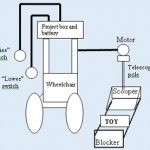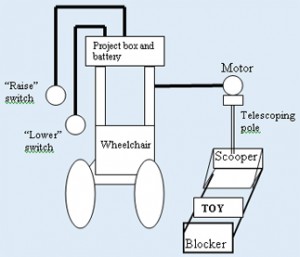Designers: Punita Christopher, Venkat Ramshesh & Vinay Tannan
Client Coordinator: Lilee Bonzani, Occupational Therapist, Durham Developmental Evaluation Center
INTRODUCTION
Our client is a two-year-old boy with a spinal cord injury at C-7, resulting in paralysis below the chest. He has normal cognition and uses a wheelchair for mobility, and his need is for a device that helps him fetch toys off the floor from his wheelchair. People currently use commercial grabbers and reachers to fetch a range of objects, but these devices require significant strength in the arm and grip that our client lacks; also they are awkward for fetching flat objects. Our goal was to build a lightweight retrieving device that attaches to a manual wheelchair, operates on batteries, and is easy to use. A device was built that consists of a scooper that is lifted and lowered by a telescoping pole, powered by a rechargeable battery. It requires a minimum amount of physical effort to use.
SUMMARY OF IMPACT
The device will benefit our client by enabling him to pick up objects from the floor independently. It will also relieve family members of time and stress from having to help him. Because of the simple design, our client can learn to use the Toy Retriever quickly by operation of two switches. The parents can detach the device efficiently, thus storing it easily when not in use.
TECHNICAL DESCRIPTION
The device consists of a scooper and blocker that are used to scoop the toy. When the user wants to pick up an object from the floor, he or she simply moves their wheelchair adjacent to the object, positioning the scooper just behind the toy as shown in figure 3. The “lower” button is then pressed, which lowers the scooper and blocker to the floor and the motor automatically shuts off. The user wheels the chair forward, which pushes the scooper under the toy. The blocker moves independently from the scooper; it sticks to the floor and helps prevent the toy from sliding away as the scooper slides underneath the toy. To retrieve the object, the user simply presses the “raise” button, bringing the scooper/blocker unit within hand’s reach. The user may then take the object from the unit as desired. The device is easy to use and accomplishes the task of toy retrieval in a fast and efficient manner.
The device was designed keeping in mind the usual toys that the client would pick up. The material used for building the scooper and blocker is Lexan, which is strong and light. The scooper and blocker are connected with a sliding joint so that they can move independently. A rubber shelf liner covers the bottom of the blocker, so that it sticks to the floor when the client moves the wheelchair and scooper forward. The scooper and blocker unit is connected to a telescoping rod, which raises and lowers the unit. This is accomplished using a commercial power antenna and motor, purchased at an auto shop. The base of the antenna and motor is connected to one end of the telescoping rod. The tip of the antenna is pushed through the hollow rod and connected to the other end. As the antenna extends and retracts, it causes the rod to extend and retract. The aluminum rod provides good rigidity compared to the relatively flimsy antenna.
When the user presses either the “lower” or “raise” switch, it triggers the circuit to turn on the motor in the appropriate direction. When the scooper and blocker are lowered to the floor or rise all the way up, the motor starts drawing a higher current. This triggers current limiters (re-settable fuses) in the circuit, which turn off the antenna motor. The battery and circuit are enclosed in a project box, completely isolated for safety. The box contains ports for 1) two switches, one for lowering the scooper/blocker unit, the other for raising it; 2) the battery recharging unit; 3) connections to the motor; and 4) a power switch. The primary source of power for the device is a rechargeable battery, which can be connected to a commercial charger through a port in the box. The parents of the client would have to recharge the battery every few days. The antenna is connected to the wheelchair rod and the scooper and blocker unit in such a way that they can be easily attached and detached.
Total cost for the project is approximately $439.
[insert photo 2 here]
Figure 2. The Toy Retriever – Scooper and Blocker design



University Operator: (919) 962-2211 | © 2024 The University of North Carolina at Chapel Hill |